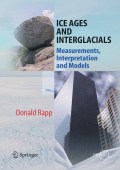
Ice ages represent perhaps the most dramatic example of extreme climate change on the Earth. Understanding how and why ice ages occur is of great importance in our wider understanding of the global climate system and how it might change. If one examines Greenland ice data for the past 100,000 years, it becomesvery clear that the relatively warm period of the past 11,000 years stand outin striking contrast to the 90,000 years of extreme cold that preceded it. Wenow refer to the unusually warm period that we are in at the present time as an interglacial; the long preceding period of cold is a glacial or ice age. During the last ice age, humans developed elaborate tools and homo sapiens migrated from Africa to Europe, but it wasn’t until that ice age ended 11,000 yearsago that agriculture began and with it the foundation of modern civilization.It is therefore not surprising that there is enormous interest in trying to work out the mechanisms which trigger ice ages to begin, and what causes them to end. Provides an independent and complete summary of the latest data on ice ages Explores theories and makes comparisons with the all the available data Acts as a primary textbook on ice ages and a secondary text on climate change Uniquely reviews all information known about ice ages in a scientific format The premier reference and sourcebook on ice ages Unmatched by any other book in the extent and depth of its coverage
- ISBN: 978-3-540-89679-1
- Editorial: Springer
- Encuadernacion: Cartoné
- Páginas: 300
- Fecha Publicación: 01/05/2009
- Nº Volúmenes: 1
- Idioma: Inglés
